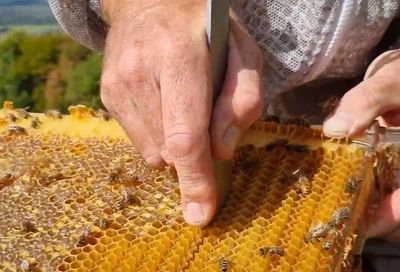The two main things we have found that increase the rate at which bees fill the Flow Frames for the first time are:
- Lots of bees on the Flow Frames.
This is the main factor. If there are not many bees when you look in the rear window and the side window, it will probably take some time for the bees to build up and start working on the Flow Frames. - A good nectar flow.
Honey won’t be stored in your hive, regardless of the number of bees, unless there are enough flowers around with plenty of nectar.
Suggestions for encouraging the bees to get working on the Flow Frames sooner:
- Timing is key – it is important to only add the Flow Super once the brood box is packed with bees, and the last timber frame has been built out. Make sure it is the right season, and there will be flowering plants for the bees to collect nectar.
- If you have other honey supers on the hive, removing some, or all, of them so that the Flow Super fills with bees. This is likely to allow for much faster results.
- Pressing some beeswax into the surface of the Flow comb can encourage them to get working on the Flow Frames earlier. You can use chunks of burr comb, wax foundation or wax cappings. The bees will then re-distribute the wax onto the Flow Frames and start working them.
- Heat up some beeswax and paint it onto the Flow Frame surface. If you try this, be careful not to get too much wax in the base of the cells, or in the upper movement mechanism, as this may jam the mechanism when it comes time to harvest.
- The speed in which the bees fill the Flow Frames varies greatly. We’ve witnessed colonies complete all the frames quickly, sometimes within a week or two, and other hives make slow progress to get started for the first time.
Bees don’t always do what we would like them to. When comparing two Flow Hives beside each other of similar strength one customer reported, while one hive filled the Flow Frames quickly, the other took its time to start on the Flow Frames.
If your bees are taking their time to start storing honey in the Flow Frames you may like to try one of the solutions suggested above. Please let us know how your hive goes.
What to expect as the bees start to work on the Flow Frames:
- First the bees tend to seal the joins in the top and bottom of each cell. They will use either new wax they produce or recycle wax from elsewhere in the hive;
- Then they start to complete the cell walls;
- Once completed they start to fill the cells with nectar;
- Then they draw the combs out beyond the Flow Frame with their wax;
- Typically, they start toward the centre of each frame and work their way out towards the edge (however every colony, and often group of working bees, may do things a little differently!);
- Once the honey is ready and the cell is full, they cap it with wax;
- When you can see mostly capped cells in the end frame view, it’s likely that the rest of the frame is mostly capped and ready for harvest.
We have done a lot of testing with Flow Frames in the same hive box as other types of traditional timber frames.
The preference from hive to hive varies, but we have generally found that naturally drawn comb on a wooden starter strip is built on first, followed by Flow Frames and wax foundation at a similar time. Plastic foundation typically seemed to be the last to be built on.
Bees waxing the gaps
Capped side window
Bees capping a flow frame
If you have feedback on this please write to us.
Still wondering?
Read more on how to get bees to take to your Flow Frames in our blog post "Why aren't my bees filling the Flow Frames?".
Read more on whether bees fill the Flow comb at a similar rate to wax comb in our FAQ.



